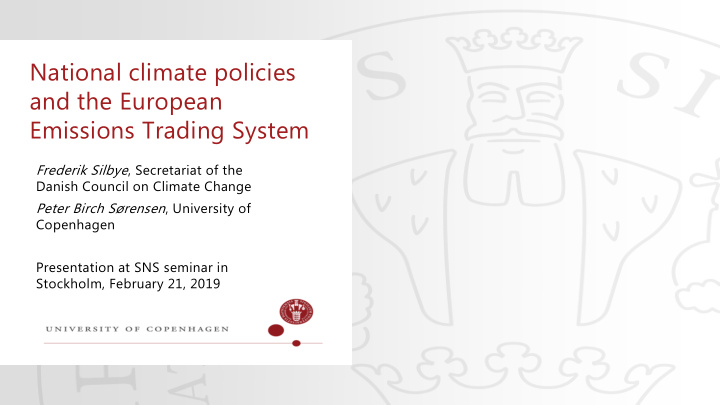



National climate policies and the European Emissions Trading System Frederik Silbye , Secretariat of the Danish Council on Climate Change Peter Birch Sørensen , University of Copenhagen Presentation at SNS seminar in Stockholm, February 21, 2019
21/02/2019 2 Issues • What are the prospects for the European carbon market after the 2018 reform of the ETS? • Are national policies aimed at reducing emissions from the ETS sector ineffective?
21/02/2019 3 Main messages • The surplus of ETS emission allowances is likely to persist for several decades even after the 2018 reform • The new Market Stability Reserve fundamentally changes the ETS: National climate policies that reduce the demand for emission allowances may now reduce emissions permanently • During the next couple of decades, a national policy that promotes renewable energy via subsidies or carbon taxes is more cost-effective than annulment of emission allowances
21/02/2019 4 Background to the recent ETS reform
21/02/2019 5 Rules of the ETS For every emitted ton of CO 2 , an installation within the ETS • must surrender an allowance Surrendered allowances are cancelled • New allowances are issued each year at a declining rate • Some new allowances are auctioned, others are allocated • cost-free Allowances are tradable and can be banked for later use •
21/02/2019 6 Problems: The huge allowance surplus...
21/02/2019 7 ...and the unstable allowance price (Euros per ton of CO 2 , monthly averages) 30 EUR per ton 25 20 15 10 5 0
8 Controversy: Two opposing views on national climate policy
9 A sticking point: The waterbed effect Economists have emphasized the waterbed effect, but the recent ETS reform has punctured the waterbed
21/02/2019 10 The recent ETS reform
21/02/2019 11 Reform: The Market Stability Reserve (MSR)
21/02/2019 12 Evaluating the reform: A simple model of the ETS • A 1 euro rise in the allowance price reduces annual CO 2 emissions by 2.2 million tons (Sandbag) • For a given allowance price, the demand for emission allowances falls year by year due to progress in green energy technologies • No one will hold a surplus of allowances unless they expect an increase in the allowance price • The supply of allowances follows the rules prevailing after the recent ETS reform in all future years • The model is calibrated to replicate the market situation in 2017-18
21/02/2019 13 Prospects for the ETS after the 2018 reform
21/02/2019 14 Model forecast
21/02/2019 15 Effects of national climate policies
21/02/2019 16 Alternative national climate policies • Subsidies to renewable energy and carbon taxes on emissions from the ETS sector reduce the demand for emission allowances • Annulment of emission allowances (e.g. via a cut in auctioned allowances) reduces the supply of emission allowances
21/02/2019 17 Effects of a national expansion of renewable energy
21/02/2019 18 Effects of a national annulment of allowances
Recommend
More recommend